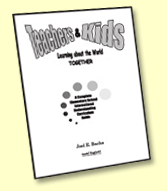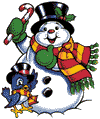 NEW!! Joel has just published a new International Understanding book, including English and cultural topics and activities, timelines for each grade level, example lesson plans, and more NEW!! Joel has just published a new International Understanding book, including English and cultural topics and activities, timelines for each grade level, example lesson plans, and more Click here for details! |
 NEW!! Joel has just published a new International Understanding book, including English and cultural topics and activities, timelines for each grade level, example lesson plans, and more NEW!! Joel has just published a new International Understanding book, including English and cultural topics and activities, timelines for each grade level, example lesson plans, and more Click here for details! |
I like to start off the first five minutes
of a class genki. I usually start by
reviewing a phrase or two; anywhere from
'Hello' to 'What's the weather like?'
This gets everyone into English mode and
creates a relaxing environment with the ALT.
I usually try to include a game along with
it.
Some fun activities for phrases are:
- Tell everyone they have to practice the
phrase with 5 people. The first person
to speak with 5 people wins.
- Give everyone 1 minute. They have
to practice the phrase with as many people
as they can. The student who talks
to the most people wins.
- The gokiburi game.
- Sit in a circle and have the kids go around
and say the phrase to the person sitting
next to them. Time how long it takes
to go around the circle. If you have
two or more circles, the circles can race
each other. (you can make many variations
of this game.) (see also the Stopwatch game)
-This is great to do as an introduction,
it is something you can build on throughout
the year, and it gives you an opportunity
to talk with each student. Make sure
everyone
has their passport, you can make these
or
find one in AJETs 'Team Taught Pizza.'
book.
Have students line up and go through
'passport
control.' As they go through
they have
to practice the taught phrase with
you. When
they do they get a stamp or a sticker
or
something WAY COOL!!!
(There is also a "passport" included
with the Genki English Worksheets pack!)
Teaching culture can be tons of fun!!! Have
fun with it!!! It can be incorporated into
almost any lesson. However, the great thing
about teaching is that it doesn't always
have to be done in the classroom. You can
teach culture in the hallways, outside on
the playground, or when going home from school.
The best way to teach culture is just by
being yourself. Elementary students are quick.
They'll notice your differences almost instantly
and will be quick to catch on. Once you get
a feel for your elementary school, teaching
culture will come naturally. For me, I began
by giving a few students High 5's. Now most
students are giving each other High 5's.
Different hand-shakes are a lot of fun too.
Some of my kids even say 'Dude.' No, I didn'tintentionally
do this!!! J
Songs are a great way for younger students
to practice speaking English. What songs
should you sing? Well, think back to those
childhood songs you used to sing. Try them
out. They may just work. Here are a few ideas
for you:
Head, Shoulders, Knees, and Toes (have the
kids make up their own body parts song.)
The Hokey Pokey
Happy Birthday
London Bridge is Falling Down ( Full "London
Bridge" Lesson Plan!)
10 Little Indians
Old MacDonald
ABC Song
A cool activity for songs is to break the
kids up into groups and have them make their
own actions to songs.
Other songs with real practical phrases are
also great, such as songs found on the Genki English CD and songs found elsewhere that contain practical
phrases. After singing you can demonstrate
the phrase in a practical situation.
It's amazing how much and how easily the
kids remember. WOW!!!
 HOLIDAY IDEAS
HOLIDAY IDEAS
Teaching about holidays is a great
way to
teach about culture.
Some things I have done are;
Drawing and making pumpkin faces and
monster
masks
Making Turkeys from hands
Making Turkey feathers to be put on a featherless
turkey
Making Christmas stockings and filling them
with something (ie. stickers) when X-mas
comes
Making Ginger Bread Houses- YUM!!!!
![]() Coloring Easter eggs
Coloring Easter eggs
Making holiday cookies and decorate with
frosting- DOUBLE YUM
 Advent Calendar (3-6nen, 20-25 min)
Advent Calendar (3-6nen, 20-25 min)
Great way to review numbers and teach about
X-mas at the same time. Make a X-mas tree
that you can leave up in the class room until
X-mas. Also make some sort of calendar. Have
the students make ornaments for the X-mas
tree and have sensei make the star. Have
each of the students pick a number (1-24),
of course they have to say what number they
chosen.speaking practice. Call out numbers
randomly from 1-25. When a student's number
is called they have to come up and put their
ornament on the calendar. As each day of
the month passes the students will take their
ornaments off the calendar and put it on
the tree. Ask sensei to have the students
say what day it is in English since you won't
be around everyday. The teachers are usually
very happy to contribute to your teaching.
Oh yeah,.#25, which is the star to top off
the tree, is usually special. Make
sure the teacher knows this. Perhaps
he or she can make a game out of who gets
to put it on top of the tree. If you
have more than 25 students in the class,
start the calendar in November, double up
on ornaments, or have some students make
some presents to go under the tree, just
be creative.. J
 TEACHING BODY PARTS
TEACHING BODY PARTS
Sing 'Head Shoulders, Knees, and Toes.'
Break the kids into groups and have them
create their own songs and/or actions.
Sing 'The Hokey Pokey.' Same as above.
Hand out a picture of a person's torso, arms,
and legs to each student. Review body parts
by holding up your hand and saying 'hand,'
pointing to your ear and saying 'ear,' etc.
After reviewing a body part, have the students
draw that body part on the picture.
Split the class into two or more teams. Draw
two pictures of a person's torso, arms, and
legs on the board; one for each team. Lay
numbered cards face down on a desk. Each
number corresponds to a body part (1-eye,
2-hand, etc.) Have one person from each team
come up to the front of the class. Say 'show
me your (body part).' The person to show
that body part first wins. They get to choose
a numbered card for their team. If they choose
1, they get todraw an eye, or whatever body
part corresponds with 1, on their team's
picture. The first team to complete the picture
wins. If a team chooses a number card and
the body part(s) have already been drawn,
TOO BAD!!! They only get one chance
to draw. This adds a bit more excitement
to the game and usually gives the slower
team a chance to catch up. Note: for older
kids I add in 'right' and 'left' (ex. Show
me your right hand).
Also, Check out the Body Building Game
Create a large sheet of paper, big enough
for five people to stand on. Put four different
colors on the paper. Have 5 students stand
around one sheet. Create cards and choose,
or call a color and right or left hand or
foot (ex. Right hand green). The students
then have to put whatever is called on that
color (ex. Put right hand on green). The
right hand must stay on green until the 'right
hand' is called again. Only hands and feet
can touch the ground. If someone falls they're
out. This is great fun and usually goes until
there is one person left standing, bowing,
bent over, not fallen.whatever. It's
also a great opportunity to have the students
speak by having them call out colors and
body parts.
The main point of this game is to teach 'I
like...' However, it's also great review
for colors and vocabulary. The kids get to
practice some speaking too.
For 3 nensei (3rd year):
Prepare a set of color cards. Place
these cards face down on the desk in the
front of the class. Split the class into
2 or 3 teams. Have one student from each
team come up to the front of the class. Say
'Go!' and each student must grab a color
card. They must run around the class
and find something in the class with the
color they chose, grab it, then run back
to the front of the class and say, "I
like (color)." For example, if
a student picks the color black; he or she
must find something in the class that is
black, grab it, run back to the front of
the class and say, "I like black."
The first student who does it wins!!!
EASY!!! FUN!!!
For 4-5 nensei:
Add in a set of picture cards. Set
the picture cards up in the back of the class.
a point for their team. This time, Say 'Go!'
and each student grabs a color card, then
they run to the back of the class and find
a picture card they like. After they
find something in the class with the color
they chose, grab it, then run back to the
front of the class and say, "I like
(color) (picture card)." For example,
if a student picks the color black and then
runs to the back of the class and grabs a
picture of a banana; after grabbing something
in the class that is black and running back
to the front of the class, they should say,
"I like black banana(s)."
For 6 nensei:
If they've played this game before, have
them put and adjective in front of the color
and picture card. anything they want to say.
For example, "I like scary black bananas"
or "I like big blue pigs."
It's amazing what some of the kids come up
with.
Divide the class into two teams. Put a piece
of newspaper on the floor in the front of
the class. Have one student from each team
stand on either end of the newspaper with
their backs facing each other. Hold up a
card and the first person to say what it
is gets to take a half step backward. Continue
this until the heals of the two students
touch. When they do, it's SUMO TIME!!!! The
students try to push each other off the paper
with their bumbs. The first student to step
off the paper loses and the other team gets
1 sumo point. Great Great GREAT FUN!!!!!
See also "Newspaper Sumo"
There are two types of karuta that I use:
Make teams and have one student from each
team race to find the picture, letter, color,.etc.
The student who wins gets a point for their
team. The team with the most points when
finished wins. Create groups of about 4 or
5. Prepare a set of cards (whatever you're
teaching; animals, numbers.) for each group.
Have the students stand up around the cards
and put their hands on top of their heads.
Call out a card and the first person in the
group that touches the card gets to keep
it. The person with the most cards in the
end wins.
(see also Richard's Karuta page)
In Japan, students are not taught the alphabet
in schools until their 4th year, and many
times incorrect pronunciation comes along
with it. The alphabet book is
a great way to expose the younger children
to the ABCs and the phonics of pronunciation
at an early age and learn some fun vocabulary
at the same time.
Make out a sheet with two letters on it.
Next to each letter put a small picture.
For example, if you are introducing 'A' &
'B,' draw or cut out a picture of an apple
and put it next to the letter 'A' and perhaps
a picture of a banana, boy, and or bird for
the letter 'B' (see ABC vocab on Joel's shogakko
plan.) Next to the pictures have a
box where the students can draw the picture
themsleves. Introduce the letters and
their pronunciations. Then introduce the
pictures and ask what letters they begin
with. Hand out the alphabet sheet and
have the students draw the picture they like
in the box (good for a future "I like
___" lesson.) I also have a place
for them to practice writing the letter.
After, you can play a game or two with the
new vocabulary (ie karuta.)
I created a whole book and gave one to each
1 nensei at the beginning of the 3rd term.
They leave the book in the classroom.
After I teach a few letters and play games
with their vocab, the students can take out
their book anytime (during break or at lunch),
draw the picture they like, and practice
writing the letter. This is great to
the student's vocabulary because they're
able to practice English when I'm not there.
The teachers also say that the students often
help each other with the pronunciation of
the ABCs and vocab.
Joel Bacha
Email: joel@genkienglish.net
Also have a look at Joel's Year Plan
and Joel's Brand New Curriculum Guide Book with loads more ideas!
Å@
Sign up to get my top tips, games & hints via email! |
 |
|---|
|
|